What: The two banners are very eye-catching:
They're advertising the services of a couple of tattoers, HORI and MORRI. The design on each is very similar. Is it a dragon and a phoenix?
From their names and designs, they're Japanese, something stated more clearly further along the road by one of their competitors:
"Professional tattooer from Japan"
Who: Apart from the tattoers, the signs show some of the other people working here. For the foreign market there are a couple of cobblers making boots and shoes:
And a compradore / grocer:
Nothing very exciting there! How about the Chinese signs? If you can read them, are there any interesting businesses?
Where: The title of the photo is "China-town. Wan-tsai", so somewhere in Wanchai. The Compradore's sign gives us the street name, Queen's Road East, but I can't make out the street number:
So which section of Queen's Road East are we looking at?
There was a famous Japanese store, Daibutsu, at the western end of the Queen's Road East on the corner with Arsenal Street. Here's a photo of it, with Queen's Road East stretching off into the distance, and Arsenal Street leading off to the left:
Shop owners of the same nationality often cluster together, so the tattoers' shops could well have been near here.
It would also make sense for them to be as far west as possible, to be close to their potential customers. Just beyond Arsenal Street were the British Army's Victoria Barracks, and the "Naval Department Buildings", shown in another photo from this collection [1]. I wonder how many soldiers and sailors returned to the UK sporting a tattoo from Hori or Morri?
One more clue to the location is the building in the distance of the original photo:
It is quite different from the shophouses in the foreground. Does anyone recognise it?
When: This photo is one of set taken by R C Hurley [2] around 1901-1902. He published them as a collection titled "Views of Hong Kong".
If you can see anything else of interest in this photo, please let us know in the comments below.
Thank you to Janet Hayes, who kindly donated this photo.
Regards, David
Photo reference: NDA23
Trivia: Tattoer to royalty!
I didn't find any mention of Hori or Morri in the local newspapers, but D Noma was a regular advertiser, claiming to have tattooed both the Duke of York and the Emperor of Russia!
|
Also on Gwulo.com this week:
|
References:
- c.1901 - "The Naval Department Buildings, Queen's Road": http://gwulo.com/node/22681
- R C Hurley: http://gwulo.com/node/22682
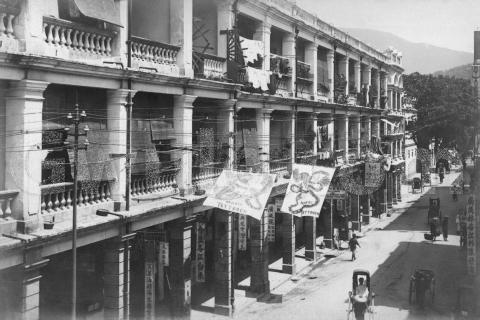



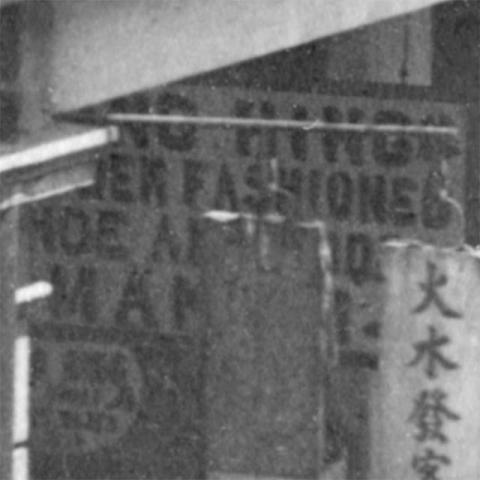
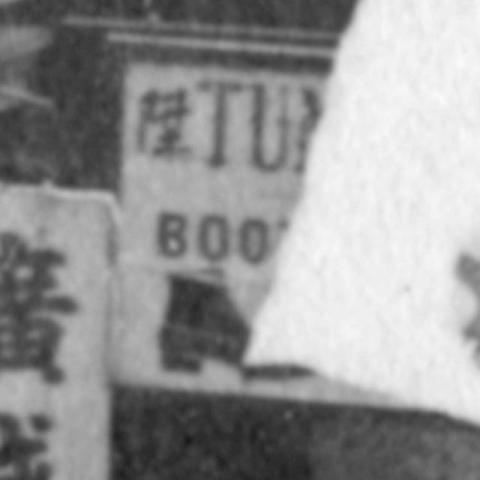

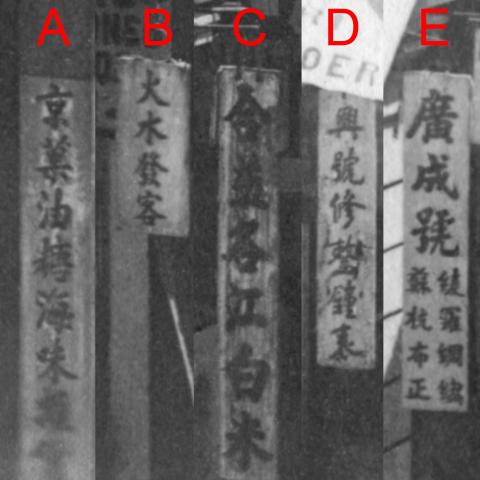

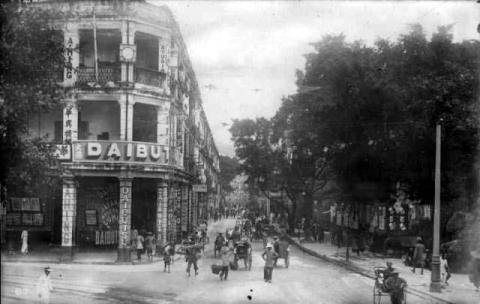
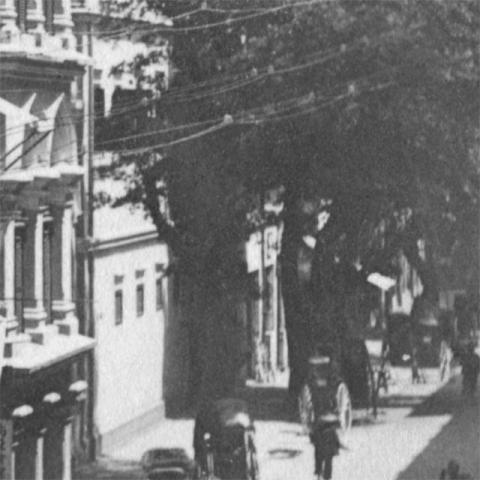
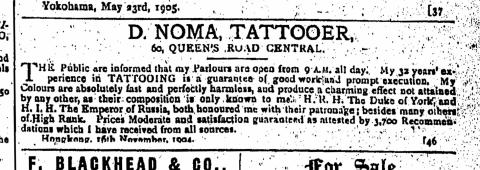
Comments
Chinese signs
Hi David,
Haven't said anything here for a while. Just had a cursory look at the Chinese signs, and I could see the following:
a - Sells condiments, oil, sugar, dried seafood and something else that I can't read down the bottom.
b - Seems to sell kerosene, but I may be wrong.
c - "Hop Yick" (Hop Yick store) sells various varieties of white rice.
d - "Something Hing" store repairers of watches and clocks.
e - "Gwong Sing Ho" (Gwong Sing store) sells cloth. It claims to have cloth from Suzhou and Hangzhou, traditional leaders in making the finest Chinese cloth.
f - I suspect it is "Gwong Wo", a grocery shop. The two characters in the vertical sign behind is "kerosene".
g - Should be the Chinese sign of store F, "Gwong Wo Ho" (Gwong Wo store) claiming to sell Western goods.
h - The top two characters refer to Chinese medicine, but I can't read anything else.
i - Top two words are "south-north", then among illegible words I can see dried seafood and oil. No doubt some sort of grocery shop selling Chinese goods too. In those days, lots of shops claim to be "south-north traders" (南北行), selling Chinese food and medicine from all parts of the country. This may be one of them.
j - This is a strange one that I don't understand. Top three characters should be the name "Gwong Mau Lam", and it seems to sell a particular kind of wood from various places (各江杉集). Again, I may be wrong.
If they really were what I think they were, then this place seems like a bustling commercial thoroughfare with cutthroat competition. It must be a noisy, busy part of Queen's Road East.
I eagerly await enlightenment from other Gwuloers on the other words and some of those puzzling products.
breskvar
re: Chinese signs
Hi Breskvar,
Thanks for helping translate these. Looks like the local residents could do all their shopping in this one area, then drop off their shoes to be mended while having a tattoo!
Regards, David
Sign J
Over on Facebook Jessica agrees that sign J is for a business selling wood: https://www.facebook.com/photo.php?fbid=10204775984332873&set=p.1020477…
In the comments she adds:
P.S. In early day, the area around Anton Street / Landale Street / Wing Fung Street / Monmouth Path was called (杉排), coz many traders ran the wood business over there.
Regards, David
Hori & Morri
Thank you to Yoshimi Yamamoto who has written in with extra information about these signs:
Dear David,
I am Japanese cultural anthropologist, Yoshimi Yamamoto. My major is Japanese tattoo and tattooist history: http://www.japantimes.co.jp/life/2014/05/03/lifestyle/japan-inked-country-reclaim-tattoo-culture/#.VNDgrWccRjo
I am looking for information of oversea Japanese tattooist. So find this page on your site. c.1901 Queen's Road East. Thank you so much!!!!
I find four names of old Hongkong Japanese tattooists in Japanese National Archives's Record and Diplomatic Archives of the Ministry of Foreign Affairs of Japan.
From 1883 to 1909 or so, Japanese tattooists were working in Hongkong. Tattooing was prohibited in Japan at that time, so some of the Japanese tattooist were looking for new job. They went to Hong kong and Singapore, Bangkok, Manila... etc.
In 1907, 46 Japanese tattooists worked in Hong Kong, according to the Diplomatic Archives of the Ministry of Foreign Affairs of Japan.
The most famous tattooist was Noma (your trivia AD). Noma's studio was in 60 Queen's Road Central. He is mentioned in a book published in 1937 by the consular staff "Otsujiro Okuda" (明治初年における香港日本人”, see http://sen1818.exblog.jp/1549452/ by sen1818's blog)
In the book he described a round-table talk of the old Japanese people about Old Hong Kong (from 1890 to 1910). According to the table talk, all the tattooist were Japanese at that time. The early Japanese tattooist was tattooing to the sailor of the Russian warship. Most famous tattooist was Mr. Noma. Noma was kindly man. He lodged homeless Japanese in his house.
I found many Noma's articles to English and USA , Hong Kong newspapers. It is very interesting for Oversea Japanese studies.
"Professional tattooer from Japan " is Ikuta . Ikuta's studio was at 54 Queen's Road. Ikuta's full name was Mr.Kokichi Ikuta 生田幸吉
by the list. I believe this shop was his tattoo studio. It stayed in business til 1937.
Hori meens tattooist title in Japan. So many Japanese tattooists used it to form their name, "Hori-XX". For example, Horikiyo, Horichyo, Horikane ,etc.
Your find "Morri" doesn't appear in the list of tattooist's names.In generally, Morri is strange name in Japan. It might be 森 or 毛利, though they are usually written Mori or Mohri. So it may be that it was just spelled wrongly, though I think that Horimorri is little bit funny name so maybe he wasn't Japanese?
I will be very interested to see any other old photos and postcards of old Hongkong tattoo studios.
yours truly,
Yoshimi Yamamoto Ph.D
Thanks very much for this additional information. I wonder if Ikuta's studio at 54 Queen's Road was on Queen's Road Central, near to Noma's? If the address is for this photo, today's 54 Queen's Road East is between Anton and Landale Streets, and the block wouldn't be wide enough to match the shops in the photo.
Has anyone seen any other old photos of tattooists in Hong Kong?
The terrace looks similar to
The terrace looks similar to this view of Queen's Rd East in 1953:
Early Japanese tattooers in Hong Kong
Some more of Yoshimi's research on this topic can be read at:
https://translate.google.com/translate?sl=ja&tl=en&u=https://synodos.jp…
In particular, look for the section titled "Tattooists who went abroad".
Thank you to Yoshimi for providing the link to the original Japanese document.